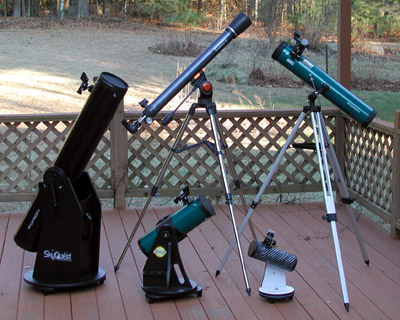Updated 10 Nov 2016
Amateur Astronomer's Notebook
Excellent
"First" Telescopes
Examples of beginner telescopes (click image to enlarge).
Introduction:
The purpose of this page is to help people who are looking to buy their first telescope. If you have looked around the web already you have probably noticed that there is a myriad of choices when it comes to telescopes, and often someone new to the field is overwhelmed and confused as to what scope might be best for a particular situation. My goal is to help you pick out the best scope for your (or your child's) area of interest. Each of the scopes I recommend have the following attributes in common:
- The design of these scopes maximizes "what you'll
be able to see" versus "how many useless accessories" they
come with.
- The capabilities listed for the scopes are honest and
true (unlike those that are often claimed for many "department
store" telescopes).
- They are simple to set up and use.
- The scopes I recommend are among the best performers
available within the price class.
You may have seen a number of beginner telescopes (both on line and in stores like Wal Mart) that have features that will locate objects for you (many of these claim object databases including thousands of objects to locate and view). All but one of the scopes that I recommend below do not locate objects (you have to manually find the objects). Why do I not generally recommend beginner class scopes with object location (often called "go to" scopes) functions? The bottom line is that entry level scopes with this feature are not very good at actually placing the desired object into the telescope's low power eyepiece. Some are better than others and most will get you close to where you want to be, but in my experience in the field scopes with these features are more of a source of frustration. In addition, the object location feature can add $100 - $200 to the price tag of an entry level scope. For beginner telescopes, it is better in my opinion to get a basic telescope that emphasizes quality viewing as compared to one that can find things for you. Learning your way around the sky is part of the fun of astronomy and it will increase your overall enjoyment of the hobby. Also, for $400 (the typical cost of an entry level go to scope) you can get a manual scope with far greater viewing capabilities as compared to a go to telescope. Based on all of this my recommendation is to start with a traditional manual telescope. That said, I realize that some people may want a scope that can locate objects for you (I've included one example below). You can read much more about what to expect in my article Advice for First Time Telescope Buyers.
On this page I list several scopes that are excellent choices for a first instrument. For each scope I will describe what makes them good choices. All of the scopes below are within the budgets of just about everyone (from around $60 to around $500 including shipping), so you won't have to worry about taking out an equity loan to get started in astronomy! Why take my advice? I've been into astronomy since 1973 (read about how I got started in astronomy here). I have used many telescopes during that time and I also built my own Backyard Observatory. If interested you can also check out a sampling of my astrophotography work. I have used Orion products since 1984 and have purchased many of their products over the years (I own several of the telescopes listed below). The Orion scopes are among the very best performers in their respective price classes, the company was founded by an amateur astronomer and the customer service is excellent. Finally, astronomy is a lifelong hobby for me and I enjoy assisting those who are just starting out.
Top Recommendation:
Orion SkyQuest XT6 Classic Dobsonian Telescope
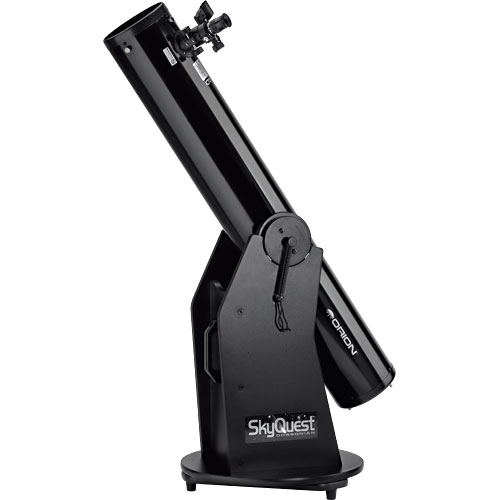
This scope is my #1 overall recommendation for a number of reasons:
- Classic 6" F8 Optical System: a time tested
"classic" configuration that is great for all astronomical
targets. This optical configuration was "the" defacto standard in the days when amateur astronomy
started taking off.
- Powerful: 6" of aperture is enough to get really
nice views of a large number and variety of objects. This is a scope of
sufficient capability and you will not outgrow it in a few weeks.
- Simple to use: The scope has two pieces that are easy
and quick to move and set up, translating to more time under the stars. It
will easily fit into most any automobile if you need to go out of town to
get dark skies.
- Quality construction: Orion is a company that
specializes in telescopes, this scope was designed by people who actually
use telescopes.
- Reviews: This scope got excellent all around reviews
from the astronomy press.
- Unbeatable value: It would be difficult to find a
better built more capable scope for the money.
- Cost: Around $350 including shipping, around $400 with
one extra eyepiece (see below).
There are some other things to be aware of:
- This is not a scope that will locate objects for you
(you can get a version of the scope that will locate objects however it is
more costly).
- This scope is for astronomy. If you are looking for a
scope for viewing scenic vistas on Earth this is not a good choice.
- This scope would be best for someone of at least 10
years of age (and higher). Younger people could use it however they would
need help moving it to the backyard.
- This scope does not come with (nor can it use) a
tripod. The base sits directly on the ground.
- This scope (in conjunction with your digital camera and
an adapter) can allow you to take some nice photos of the Moon and
possibly the brightest planets. This scope's primary use is for viewing
(photography options will be limited).
- You may have to collimate (align) the optics from time
to time. This is normal for any Newtonian reflector telescope and the
instruction manual will guide you through this task. Orion's instruction
manuals are very well written by professionals who know telescopes and
also know proper use of the English language (the manual is NOT a poor
quality one sheet "Chinese translation" type manual).
- The Red Dot finder requires button batteries (they are
supplied with the unit). They last a long time in normal use, but it you
forget to shut off the finder when you put the scope away the batteries
will probably be dead the next time you go to use the scope!
- NEVER point this (or any) telescope at the Sun unless
you have the proper filter and are familiar with how to use it. Blindness
can result.
Full details of the scope are here: Orion SkyQuest XT6 Classic Dobsonian Telescope
Recommended Extra Eyepiece: The scope comes with one quality eyepiece
that will provide 48x magnification (a perfect low power for this scope).
Although not mandatory, a second eyepiece that provides a higher magnification
is definitely recommended for closer views of the Moon and planets. The 10mm
Sirius Plossl eyepiece (around $45) would provide
120x magnification (a perfect higher power for this scope). Click on the link
to see this eyepiece: 10mm Orion Sirius Plossl Telescope
Eyepiece
Bottom line: This scope will give you the best views for the least
amount of money. This scope, combined with the 10mm Orion Sirius Plossl Telescope
Eyepiece and the book Nightwatch
(shown below)
combined will cost around $420 and will represent an excellent all
around starter package!
Alternate choice: An 8" version of the above scope. A more
powerful version of the above scope, with a higher quality focuser. This model
is a little larger and somewhat more money but also an outstanding value: Orion SkyQuest XT8 Classic Dobsonian Telescope
The SkyQuest XT8 with the extra eyepiece and the book Nightwatch will cost around $500 and is truly a fantastic package. If you are considering the XT6 but have a little more money in your budget then I would recommend seriously considering the XT8 model. It's a package that could provide a lifetime of viewing!
Some "quick
and dirty" Moon photos I took with my XT6!
Below are two photos of the Moon that I took using a very ordinary (actually outdated) digital camera. These photos are representative what most anyone could do (with a little tinkering) with even a very basic digital camera! The close up photo shows great detail and gives you a rough idea of what you can see visually through the scope at higher magnifications. Be sure to click on these small photos to open the larger versions in a new window!
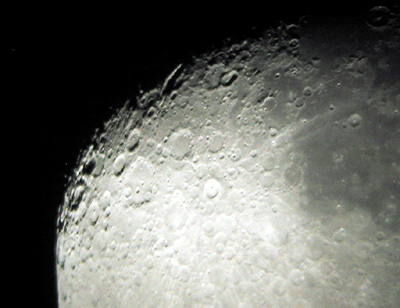 Moon, 16 December 2010 Shot with an obsolete
(3.3 megapixel) Olympus digital camera (and through some light clouds also).
Exposure: 1/100 second at F2.8. Afocal method. I
zoomed the camera lens to get this close up shot.
Moon, 16 December 2010 Shot with an obsolete
(3.3 megapixel) Olympus digital camera (and through some light clouds also).
Exposure: 1/100 second at F2.8. Afocal method. I
zoomed the camera lens to get this close up shot.
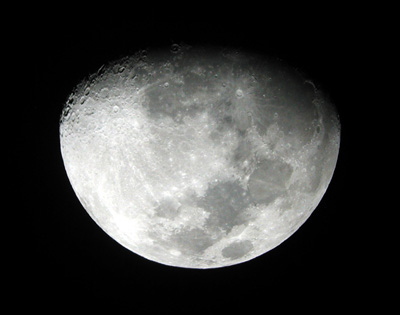 Moon, 16 December 2010 Shot with an obsolete
(3.3 megapixel) Olympus digital camera (and through some light clouds also).
Exposure: 1/100 second at F2.8. Afocal method.
Moon, 16 December 2010 Shot with an obsolete
(3.3 megapixel) Olympus digital camera (and through some light clouds also).
Exposure: 1/100 second at F2.8. Afocal method.
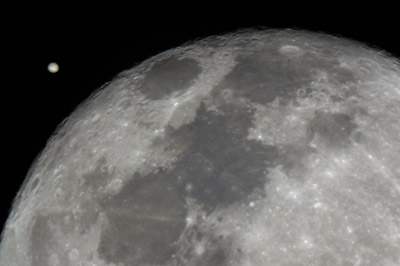 Moon (with Jupiter added in for scale), 21
December 2010 This is a photo of the Moon and Jupiter (Jupiter image was
taken separately and added in to show scale). Both images are at the same scale
to illustrate that the planets do look a lot smaller than the Moon through any
telescope. These images were taken with the XT6 with an Orion Shorty Barlow
lens in the light path using a Pentax Kx digital SLR
camera. I used the Barlow lens because without it the camera cannot come to
focus. (I will be covering more on how to take images using the XT6 in a
forthcoming article). As usual the air steadiness in New England was not very
good when I took these images (they'd be a lot sharper on a better night)!
Note: Jupiter's moons are not visible in this photo. You'll see them easily
when looking through the scope however!
Moon (with Jupiter added in for scale), 21
December 2010 This is a photo of the Moon and Jupiter (Jupiter image was
taken separately and added in to show scale). Both images are at the same scale
to illustrate that the planets do look a lot smaller than the Moon through any
telescope. These images were taken with the XT6 with an Orion Shorty Barlow
lens in the light path using a Pentax Kx digital SLR
camera. I used the Barlow lens because without it the camera cannot come to
focus. (I will be covering more on how to take images using the XT6 in a
forthcoming article). As usual the air steadiness in New England was not very
good when I took these images (they'd be a lot sharper on a better night)!
Note: Jupiter's moons are not visible in this photo. You'll see them easily
when looking through the scope however!
Additional photos
of the Orion SkyQuest XT6
Below are some photos of the XT6 and other beginner scopes (these will help you gauge the size of some of the scopes on this page) Be sure to click on these small photos to open the larger versions in a new window!
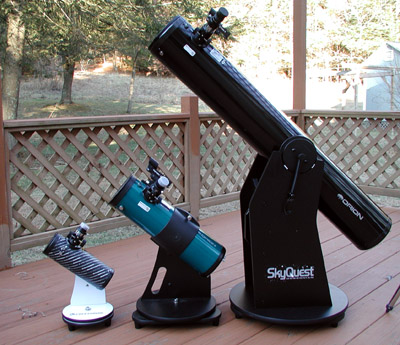 Celestron Firstscope,
Orion StarBlast 4.5 Astro and Orion SkyQuest XT6 Here's
a shot showing three popular beginner scopes, from the very small to medium
size. See the Celestron and the StarBlast below on
this page.
Celestron Firstscope,
Orion StarBlast 4.5 Astro and Orion SkyQuest XT6 Here's
a shot showing three popular beginner scopes, from the very small to medium
size. See the Celestron and the StarBlast below on
this page.
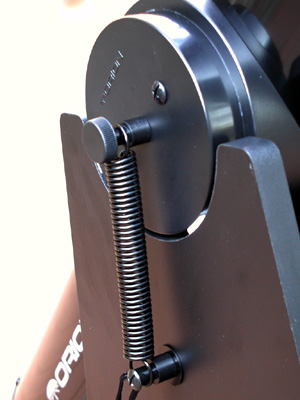 XT6 Correct Tension Detail This shot is
provided to assist anyone who just got one of these scopes and needs a shot of
what the spring assembly looks like (the photo in the manual is a little hard
to see, this photo should clear any confusion on how it should be).
XT6 Correct Tension Detail This shot is
provided to assist anyone who just got one of these scopes and needs a shot of
what the spring assembly looks like (the photo in the manual is a little hard
to see, this photo should clear any confusion on how it should be).
Top Choice for Kids
(10 and under): Orion StarBlast 4.5 Astro Reflector Telescope
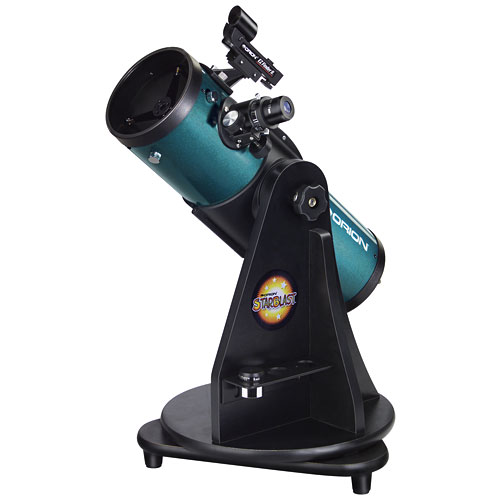
This scope is my #1 recommendation for kids 10 and under for the following reasons:
- Although intended for younger viewers this is a REAL
telescope (not a toy) and one that will perform very nicely.
- Simple to use: Just carry it outside, set it on a table
(or the ground) and you are ready to observe. The fully assembled scope
weighs only 13 pounds. This scope is small enough to fit into a car (for a
camping trip or field outing) with minimal problems.
- Powerful enough to provide satisfying images of many
objects. This scope will show a lot more than the typical first telescope
that most people start out with (a 60mm refractor).
- Quality construction: Orion is a company that
specializes in telescopes, this scope was designed by people who actually
use telescopes.
- Reviews: This scope got excellent reviews from the
astronomy press. Although this scope is aimed at younger people, there are
many advanced amateur astronomers who have one as a second scope for
"quick looks" at things when they don't have time to set up a
large sophisticated instrument. I own one of these scopes, it is very
simple to use, the mount is very steady, and it has great optics.
- Great value: This is a great all around scope that will
likely outperform similar sized scopes you might find in department
stores. Orion provides quality accessories on this scope where department
store scopes add on several practically worthless items (department store
scopes often claim a misleadingly high magnification for the scope).
- Cost: Around $235 including shipping.
There are some other things to be aware of:
- This is not a scope that will locate objects for you. If
you are buying this scope for a child you will still probably need to
assist them in getting it set up the first few times you use it.
- This scope is for primarily for astronomy. It can also
be used for terrestrial viewing (objects will appear "upside down",
this is normal, not a defect)!
- This scope (in conjunction with your digital camera and
an adapter) can allow you to take some nice photos of the Moon.
- This scope does not come with (nor does it require) a
tripod. Ideally it needs to be placed on a small table for comfortable
viewing.
- You may have to collimate (align) the optics from time
to time. This is normal for any Newtonian reflector telescope and the
instruction manual will guide you through this task. Orion's instruction
manuals are very well written by professionals who know telescopes and
also know proper use of the English language (the manual is NOT a poor
quality one sheet "Chinese translation" type manual).
- This telescope is meant for lower magnifications (it is
fantastic on the Milky Way, star clusters, etc.). This telescope can
provide very nice views of the Moon and planets, however if these will be
your PRIMARY targets, I recommend that you seriously consider the Orion SkyQuest XT4.5 Classic Dobsonian Telescope
instead (see the next scope on this page). The SkyQuest XT4.5 has a longer focal length and is inherently better for lunar and planetary viewing.
- The Red Dot finder requires button batteries (they are
supplied with the unit). They last a long time in normal use, but it you
forget to shut off the finder when you put the scope away the batteries
will probably be dead the next time you go to use the scope!
- NEVER point this (or any) telescope at the Sun unless
you have the proper filter and are familiar with how to use it. Blindness
can result.
Full details of the scope are here: Orion StarBlast 4.5 Astro Reflector Telescope
Prefer a tripod mounted version of this scope? This is the one to get (a
little more money): Orion StarBlast 4.5 Equatorial Reflector Telescope
Bottom line: This scope is arguably one of the best all around choices for a child who is just starting out in astronomy. Its capabilities are considerably more than those of the common 60mm refractor that is often given as a "first" telescope. This scope is a winner!
Here's a shot of the Moon I took using the StarBlast Astro. This is roughly what the Moon will look like using the low magnification eyepiece that comes with the scope (You'll be able to see quite a bit more detail using the higher magnification eyepiece that also comes with it):
![]()
Here are a couple of shots of me using my StarBlast Astro (set up on the edge of a deck):
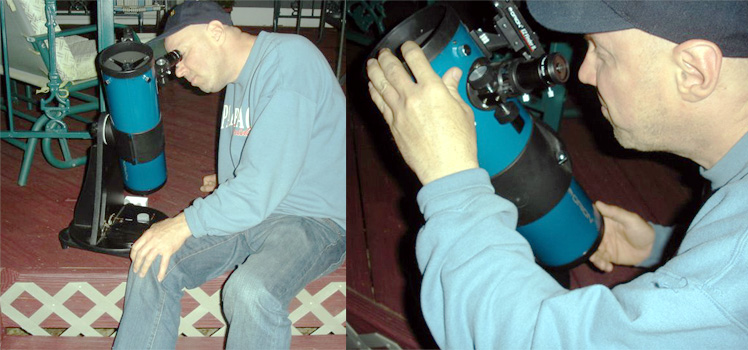
Want something very similar but with more capability (and still quite
portable)? The Starblast 4.5 Astro has a big
brother called the Orion StarBlast 6 Astro Reflector Telescope. This telescope
sells for around $330 (including shipping) and comes with 2 excellent quality
eyepieces.
Top Choice for a
young person (10+ years): Orion SkyQuest XT4.5 Classic Dobsonian Telescope
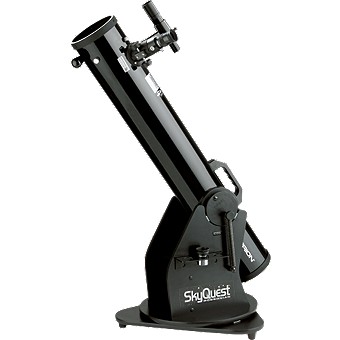
This scope is a great choice for a younger person (10+ years) and for those who can spend around $260. Here's why:
- Simple to use: Just carry it outside, set it on the
ground, and you are ready to observe. The fully assembled scope weighs
only 18 pounds.
- Powerful enough to provide satisfying images of many
objects. This scope will show a lot more than the typical first telescope
that most people start out with (a 60mm refractor).
- This scope comes with two very good eyepieces that are
perfectly suited to this scope (providing 36x and 91x), there is nothing
extra to buy!
- Finderscope: this telescope uses an
optical finderscope (most of the others in this
price range use a "Red Dot Finder"). The optical finderscope is a better choice for skies that have a
fair amount of light pollution.
- Quality construction: Orion is a company that
specializes in telescopes, this scope was designed by people who actually
use telescopes.
- Reviews: This scope got excellent reviews from the
astronomy press.
- Great value: This is a great all around scope that will
likely outperform similar sized scopes you might find in department
stores. Orion provides quality accessories on this scope where department
store scopes add on several practically worthless items (department store
scopes often claim a misleadingly high magnification for the scope).
- Cost: Around $270 including shipping.
There are some other things to be aware of:
- This is not a scope that will locate objects for you.
If you are buying this scope for a child you will still probably need to
assist them in getting it set up the first few times you use it.
- This scope is for primarily for astronomy.
- This scope (in conjunction with your digital camera and
an adapter) can allow you to take some nice photos of the Moon.
- This scope does not come with (nor can it use) a
tripod. The base sits directly on the ground.
- You may have to collimate (align) the optics from time
to time. This is normal for any Newtonian reflector telescope and the
instruction manual will guide you through this task. Orion's instruction
manuals are very well written by professionals who know telescopes and
also know proper use of the English language (the manual is NOT a poor
quality one sheet "Chinese translation" type manual).
- NEVER point this (or any) telescope at the Sun unless
you have the proper filter and are familiar with how to use it. Blindness
can result.
Full details of the scope are here: Orion SkyQuest XT4.5 Classic Dobsonian Telescope
Bottom line: This scope is a great choice for a young person starting out in astronomy. If you really want the SkyQuest XT6 (the scope at the top of this page) but don't have the funds for that unit, this scope is an excellent alternative. It comes with two very good eyepiece and an optical finderscope (basically it comes with everything you need right out of the box). This telescope's capabilities are considerably more than those of the common 60mm refractor that is often given as a "first" telescope.
Excellent Choice
for a Very Limited Budget (~ $120 including shipping):
Orion SpaceProbe 3 Altazimuth
Reflector Telescope
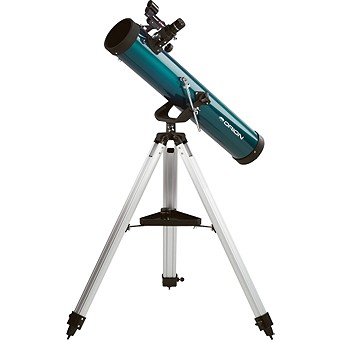
This is one of your very best choices if you can only spend around $120. I personally own one and it gives very nice views especially considering its size. Here is more info on the scope:
- Simple to use: Just carry it outside, set it on the
ground and you are ready to observe. The fully assembled scope weighs only
9 pounds, light enough for most anyone to carry.
- Although it is a basic scope it is powerful enough to
provide satisfying images of many objects. Provides excellent views of the
Moon!
- Quality construction: Orion is a company that
specializes in telescopes, this scope was designed by people who actually
use telescopes.
- Reviews: this scope has not been reviewed by the
astronomy magazines however I can state that in owning one it is very good
(among the best in this price class). See my detailed review of this scope
here: Detailed Review of the Orion SpaceProbe 3 Altaz Reflector
Telescope.
- Great value: it comes with 2 good eyepieces that are
well matched to the scope (28x and 70x). It also comes with an easy to use
red dot finder scope.
- Cost: Around $120 including shipping.
There are some other things to be aware of:
- This is not a scope that will locate objects for you.
If you are buying this scope for a child you will still probably need to
assist them in getting it set up the first few times you use it.
- This scope is for primarily for astronomy (you can use
it for daytime scenery but the images will appear "upside
down").
- This scope (in conjunction with your digital camera and
an adapter) can allow you to take some nice photos of the Moon.
- You may have to collimate (align) the optics from time
to time. This is normal for any Newtonian reflector telescope and the
instruction manual will guide you through this task. Orion's instruction
manuals are very well written by professionals who know telescopes and
also know proper use of the English language (the manual is NOT a poor
quality one sheet "Chinese translation" type manual).
- The Red Dot finder requires button batteries (they are
supplied with the unit). They last a long time in normal use, but it you
forget to shut off the finder when you put the scope away the batteries
will probably be dead the next time you go to use the scope!
- NEVER point this (or any) telescope at the Sun unless
you have the proper filter and are familiar with how to use it. Blindness
can result.
See my detailed
review of this scope here: Detailed Review of
the Orion SpaceProbe 3 Altaz
Reflector Telescope
I took a photo of the Moon with this scope. Click on the small image below to see the full size image. Despite this being a small scope you can see that it does a very nice job in showing the Moon!
Full details of the scope are here: Orion SpaceProbe 3 Altazimuth
Reflector Telescope
Bottom line: For a little over $100 this is a very nice basic telescope that gives very sharp views of the Moon and other bright objects. Far better than the typical telescope you will find in a department store!
Good Choice for a
Very Limited Budget: Orion SkyScanner 100mm TableTop Reflector Telescope
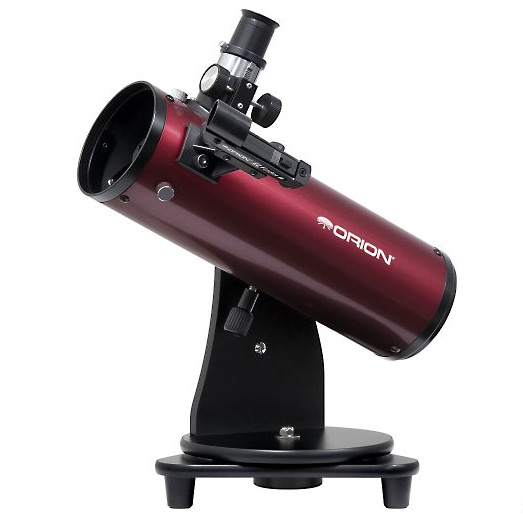
This scope is among the best picks if your budget is very limited:
- Simple to use: Just carry it outside, set it on a table
and you are ready to observe.
- A scope that will excel at wide field scanning; the
Moon will also be very nice and you'll also be able to see the bright
planets (though they will look small) and a number of the brighter deep
sky objects.
- Good basic capabilities: Orion is a company that
specializes in telescopes, this scope was designed by people who actually
use telescopes. This scope leaves out the junky accessories and provides
two decent quality eyepieces that provide magnifications that are proper
for a scope of this size. Department store scopes tend to provide
eyepieces to prop up the magnification to a preposterously high number
(due to the fact that most people associated magnification with how
"powerful" a scope is).
- Great value: This is among the most basic beginner
scopes you can buy. You will not likely find a scope that will show more
for the cost.
- A good choice for cases where a child wants a
"real" telescope and you think the interest may be fleeting (and
also don t want to spend a lot of money).
- Cost: Around $140 including shipping.
There are some other things to be aware of:
- This is not a scope that will locate objects for you.
If you are buying this scope for a child you will still probably need to
assist them in getting it set up the first few times you use it.
- This scope does not come with (nor does it require) a
tripod. It does need to be set on a small table, car hood, etc, for comfortable viewing position.
- This scope is mainly for astronomy (you can use it for
scenery on Earth but the images will be "upside down").
- This scope (in conjunction with your digital camera and
an adapter) can allow you to take some basic photos of the Moon.
- The Red Dot finder requires button batteries (they are
supplied with the unit). They last a long time in normal use, but it you
forget to shut off the finder when you put the scope away the batteries
will probably be dead the next time you go to use the scope!
- Note that the maximum magnification for this scope
(with the eyepieces that come with it) is 40x, this makes it easy to use but
some viewers will find that the planets look very small. If you want more
magnification consider one of the other scopes I list on this page (the Orion SpaceProbe 3 Altaz Reflector Telescope, although less powerful overall,
is a better choice if the Moon and planets will be your main targets).
Another option is to order this scope with a Barlow lens (this will boost
the power to 80x but will of course cost more $$). The Barlow lens to get
for this scope is here: Orion Shorty 1.25" 2x Barlow Lens
(cost around $44 plus shipping).
- NEVER point this (or any) telescope at the Sun unless you
have the proper filter and are familiar with how to use it. Blindness can
result.
Full details of the scope are here: Orion SkyScanner 100mm TableTop Reflector Telescope
Bottom line: For those with very limited budgets this is among your best choices.
Another Good Choice
for a Limited Budget: Orion Observer 70mm Altazimuth Refractor Telescope
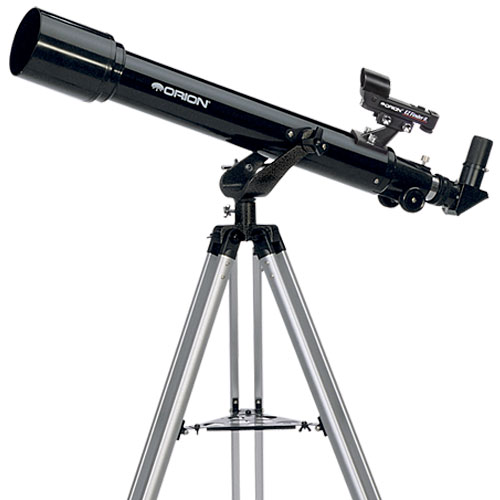
This is a great choice if your budget allows around $160:
- Simple to use: Just carry it outside, set it on the
ground and you are ready to observe.
- A scope that will provide excellent views of the Moon;
you'll also be able to see the bright planets and a number of the brighter
deep sky objects. Also a decent choice for scenic vistas on Earth.
- Quality construction: Orion is a company that
specializes in telescopes, this scope was designed by people who actually
use telescopes.
- Reviews: this scope got good reviews in the astronomy
press.
- Great value: it comes with 2 good eyepieces that are
well matched to the scope (28x and 70x). It also comes with an easy to use
red dot finder scope.
- No maintenance: Refractor scopes do not need to have
their optics periodically aligned (they are factory set).
- Cost: Around $160 including shipping.
There are some other things to be aware of:
- This is not a scope that will locate objects for you.
If you are buying this scope for a child you will still probably need to
assist them in getting it set up the first few times you use it.
- This scope is can be used for daytime use also (scenic
vistas, birds, etc); the images will br right side up but flipped "left for
right").
- This scope (in conjunction with your digital camera and
an adapter) can allow you to take some nice photos of the Moon.
- The Red Dot finder requires button batteries (they are
supplied with the unit). They last a long time in normal use, but it you
forget to shut off the finder when you put the scope away the batteries
will probably be dead the next time you go to use the scope!
- NEVER point this (or any) telescope at the Sun unless
you have the proper filter and are familiar with how to use it. Blindness
can result.
Full details of the scope are here: Orion Observer 70mm Altazimuth Refractor Telescope
Bottom line: A very nice telescope for the money, no useless accessories, just a good basic scope.
Good Choice for a
Very Limited Budget: Celestron 21061 AstroMaster 70 AZ
Refractor Telescope
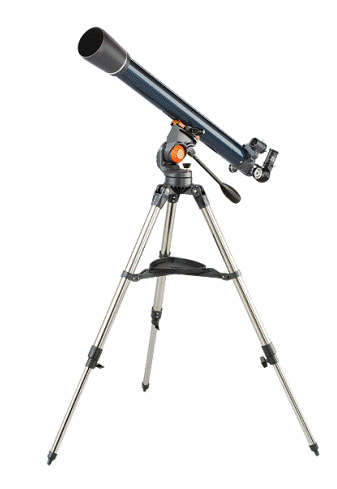
This scope is another very good choice if your budget is very limited:
- Simple to use: Just carry it outside, set it on the
ground and you are ready to observe.
- A scope that will provide very nice views of the Moon;
you'll also be able to see the bright planets and a number of the brighter
deep sky objects. Also a decent choice for scenic vistas on Earth (it has
"correct image" optics, meaning things won't appear "upside
down or backwards").
- Good basic capabilities: Celestron
makes a number of telescopes, some of them come with useless
"extras", this is not one of those. This scope leaves out the
junky accessories and provides two decent quality eyepieces that provide
magnifications that are proper for a scope of this size. Department store
scopes tend to provide eyepieces to prop up the magnification to a
preposterously high number (due to the fact that most people associated
magnification with how "powerful" a scope is).
- No maintenance: Refractor scopes do not need to have
their optics periodically aligned (they are factory set).
- Cost: Can sometimes be found for under $100 at Amazon
.
There are some other things to be aware of:
- This is not a scope that will locate objects for you.
If you are buying this scope for a child you will still probably need to
assist them in getting it set up the first few times you use it.
- This scope can be used for both astronomy and for
terrestrial viewing. However, if astronomy is your primary
interest, strongly consider the Orion SpaceProbe 3 Altaz Reflector
Telescope instead. The Orion scope is only a little more expensive but
it has better quality eyepieces and is the better choice for astronomy (I
own both of these scopes and in side by side tests the Orion is better for
astronomy).
- This scope (in conjunction with your digital camera and
an adapter) can allow you to take some basic photos of the Moon.
- The Red Dot finder requires button batteries (they are
supplied with the unit). They last a long time in normal use, but it you
forget to shut off the finder when you put the scope away the batteries
will probably be dead the next time you go to use the scope!
- Keep in mind that this scope pretty much represents the
least expensive option for starting out; expect a fair amount of plastic
(all scopes in this price range are of similar construction). If you have
the extra money, the Orion Observer 70mm Altazimuth Refractor Telescope
is the better of the these two (similar) scopes (the Orion has better eyepieces, a better diagonal and a better red dot finderscope).
- The tripod is fairly stable, however the scope can be
"stiff" to move when it is cold (the grease in the mount gets
thick). Also, I find that the scope's optical tube is slightly heavy at
the back end, making it sometimes a bit of a pain to get an object to stay
in the field of view. I have not yet tinkered with it, but this annoyance
could be fixed by placing a weight (won't take much) towards the front of
the optical tube. All in all for the price it is hard to beat this scope,
especially when you get it for well under $100.
- NEVER point this (or any) telescope at the Sun unless
you have the proper filter and are familiar with how to use it. Blindness
can result.
Full details of the scope are here: Celestron 21061 AstroMaster 70 AZ
Refractor Telescope
Two good choices
for a child that really wants a telescope (but you're not sure the
interest will last)!
There are two scopes on the market that are very basic (but are good choices in certain situations). These two scopes are perfect for a child who really wants a telescope, but you are (a) not sure the interest will last more than a week and /or (b) you want to keep costs to the absolute lowest possible. Both of these scopes are very basic performers and are virtually identical in their basic design. The first one is:
Celestron FirstScope
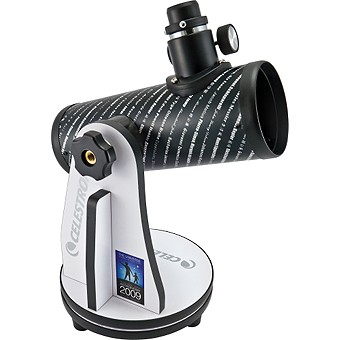
This telescope normally sells for around $50 but Amazon's
price has been as low as $35! Here is more info on this scope:
- Simple to use: Just carry it outside, set it on a table
(or car hood) and you ready to observe. The scope is small and light
enough (4 pounds) for most anyone to carry.
- This scope will provide very basic views of the Moon,
planets and the brightest deep sky objects.
- This scope comes with 2 eyepieces, one that provides
15x (low power) and 75x (enough to see detail on the Moon and bright
planets).
There are some other things to be aware of:
- This is not a scope that will locate objects for you.
If you are buying this scope for a child you will still probably need to
assist them in getting it set up the first few times you use it.
- This scope is for primarily for astronomy.
- This scope does not come with a finderscope.
However, the low power eyepiece (15x) is low enough to allow reasonably
easy location of things you want to look at.
- This is a very basic scope... don't expect world class
performance from a $50 scope! It is not a "toy" telescope
however.
- NEVER point this (or any) telescope at the Sun unless
you have the proper filter and are familiar with how to use it. Blindness
can result.
I got my FirstScope in December 2010. It's a very basic scope but it does provide remarkable views for the cost. The scope moves very smoothly and the mount is nice and stable (very little vibration). The eyepieces are of the type I don't recommend (however in a scope that sells for $50 normally there is no way to provide better eyepieces). They have narrow fields of view, but the image was better than I expected. This scope does not come with a finder scope, but you can fairly easily find bright objects by using the low power eyepiece. All in all this is a "can't go wrong for the price" scope. That said, remember it is VERY basic! A great choice if you want to keep cost to the absolute bottom.
Full details of the scope are here: Celestron FirstScope
The second scope in this class is below:
FunScope 76mm Tabletop Reflector
Telescope
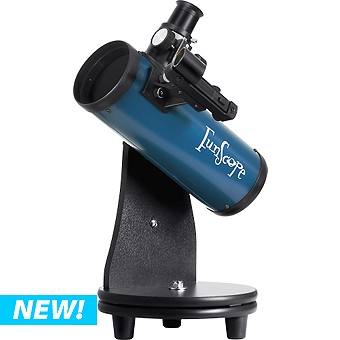
This telescope also sells for around $60. It is very similar overall to the Celestron scope just above (there are a few differences however). Here is more info on this scope:
- Simple to use: Just carry it outside, set it on a table
(or car hood) and you ready to observe. The scope is small and light
enough (4 pounds) for most anyone to carry.
- This scope will provide very basic views of the Moon,
planets and the brightest deep sky objects.
- This scope comes with 2 eyepieces, one that provides
15x (low power) and 30x. 30x is still pretty low, you'll see detail on the
Moon but the planets Jupiter and Saturn will appear very small. The Celestron scope (above) is possibly the better choice
if seeing the planets a little closer is a priority.
- This scope DOES come with a Red Dot finderscope
(this item alone sells separately for around $35 so this scope is a great
deal). This will make locating objects you want to look at a lot easier.
There are some other things to be aware of:
- This is not a scope that will locate objects for you.
If you are buying this scope for a child you will still probably need to
assist them in getting it set up the first few times you use it.
- This scope is for primarily for astronomy.
- The highest magnification possible with the supplied
eyepieces (30x) is kind of low and you won't see much detail on Jupiter
and Saturn. You can always get separate eyepieces to boost up the
magnification, however this will basically double the cost of the scope
(and if you're going to spend $100+ I'd recommend getting the Orion SpaceProbe 3 Altaz Reflector Telescope instead)!
- This is a very basic scope... don't expect world class
performance from a $60 scope! It is not a "toy" telescope
however.
- The Red Dot finder requires button batteries (they are
supplied with the unit). They last a long time in normal use, but it you
forget to shut off the finder when you put the scope away the batteries
will probably be dead the next time you go to use the scope!
- NEVER point this (or any) telescope at the Sun unless
you have the proper filter and are familiar with how to use it. Blindness
can result.
Full details of the scope are here: FunScope 76mm Tabletop Reflector
Telescope
I got my FunScope in August 2011. The basic scope is identical to the Celestron FirstScope. The differences are in the eyepieces and also the FunScope comes with a Red Dot finderscope. The FunScope's eyepieces (20mm and 10mm) provide 15x and 30x. These magnifications will be kind of low for seeing detail on the planets (you'll still see lots of detail on the Moon). The Red Dot finderscope works well and makes it very easy to locate objects. The image quality is very good considering what this scope costs.
So which of the two should I get? This is kind of a tough choice... the basic scopes are identical, both provide 2 eyepieces. The FunScope comes with the finderscope that makes it really easy to locate things to look at (the Celestron does not have this). However the Celestron comes with a 4mm eyepiece, providing 75x, and this is enough to see some detail on the planets. The FunScope's maximum magnification (with the eyepieces it comes with) is 30x, a bit low to see detail on the planets. I don't think you can go wrong with either of these scopes. Do remember that these two scopes are very basic. If you think your child will have a longer lasting interest in astronomy, one of the other scopes on this page would be a better choice. The two scopes listed just above are intended only to get your "feet wet" in astronomy!
Good choice if you
want a telescope that can locate objects for you: Celestron NexStar
4SE GoTo Maksutov-Cassegrain
Telescope
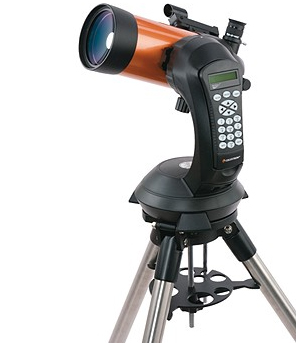
This scope is among the entry level scopes that can find things for you:
- Powerful enough to provide satisfying images of many
objects. This scope will show a lot more than the typical first telescope
that many people start out with (a 60mm refractor). It will provide
excellent views of the Moon and planets.
- Once initiallized this scope
will locate things for you (via commands you enter into a hand
controller).
- Cost: Around $550 including shipping.
There are some other things to be aware of:
- This scope DOES find things for you. As such it will
take a little more time to learn how to use it.
- This scope is for primarily for astronomy but it can be
used for terrestrial work too.
- This scope (in conjunction with your digital camera and
an adapter) can allow you to take some nice photos of the Moon.
- The scope only comes with one eyepiece (53x
magnification), you may want another one to give closer views of the Moon
and planets. I'd recommend the 10mm Orion Sirius Plossl
Telescope Eyepiece
(this will provide 132x magnification).
Full details of the scope are here: Celestron NexStar
4SE GoTo Maksutov-Cassegrain
Telescope
Bottom line: This scope is one that should do a decent job in locating objects for you!
Quality Entry Level
Binoculars for Astronomy (or Nature and Sports): Orion Scenix 7x50 Binoculars
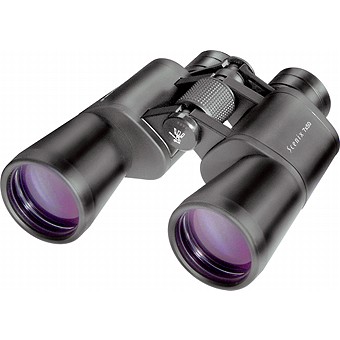
Don't think that binoculars are of no use for astronomy... they can be VERY useful (and they can be used for nature and sports too). Binoculars for astronomy are very portable compared to a telescope, very simple to use, can be used on a moment's notice, and take up almost no room in storage. As with telescopes, quite often the binoculars you will find at department stores are NOT of the greatest quality. I've seen some binoculars at CVS, Sears and "dollar stores" that sell for around $20. They look look quite similar (from the outside) to these Orion binoculars, however their performance (and build quality) is far inferior. These Orion binoculars will provide very nice views and are worth the money.
For astronomy, binoculars are great for sweeping along the Milky Way. They will show FAR more stars than the naked eye alone can see. They (assuming reasonably dark skies) can also show many star clusters, some nebulae and even a few galaxies! Some objects (large star clusters) often look better in binoculars as compared to a telescope.
What binoculars won't do is show any detail on the planets (although on Jupiter you'll be able to spot the moons as small dots surrounding the planet). On the Moon you'll be able to see some detail, but not nearly as much as a telescope will reveal. If you really want to see the Moon and planets with some detail, a telescope will be required.
These particular binoculars are a 7x50 model. The "7" is the magnification (7x) and "50" is the diameter of the optics. For astronomy, 50 and up is good (larger lenses means more light will be gathered, and the brighter things will look and more detail will be seen). Magnification of 7 is good; you don't want it too high! Once you get above around 10x magnification it becomes harder and harder to hold binoculars steady, resulting in a very shaky view. These binoculars are small and light enough to be hand held (no need for a tripod) by most anyone. 7x50 is among the best all around models for astronomy.
WARNING: NEVER point this (or any) binocular at the Sun unless you have the proper filter and are familiar with how to use it. Blindness can result.
NOTE: DO NOT buy so called "zoom" binoculars! These are binoculars that can "zoom" from a low to high magnification. Few if any of these perform even marginally. You are far better off to buy a conventional (single magnification) binocular.
If you are looking for a good book for binocular astronomy, here are two
inexpensive ones that come highly recommended: Binocular
Highlights: 99 Celestial Sights for Binocular Users (Sky & Telescope
Stargazing)
and Binocular
Stargazing
.
There are a number
of other great telescope choices...
If you have questions on these (or other models of telescope you may have found) please E -mail me and I'll try to help to the best of my ability
Excellent Books to go with your
First Telescope
Below I list a few books that are among the best for the new astronomer. Each of these will help you get started (in terms of using your new scope, what to look for in the sky, and many other useful tips for beginners). Here are several excellent books to fit most any budget:
A basic but good choice to consider with your first telescope (good for very limited budgets):
Discover The Stars
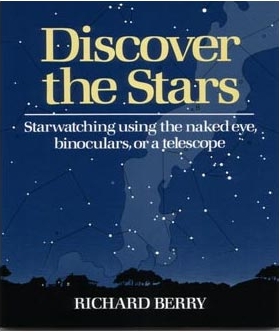
This book is around $14 plus shipping.
Turn Left at Orion
A great companion book to help get you started with your first telescope. Great for mid-level budgets, cost is around $25 plus shipping.
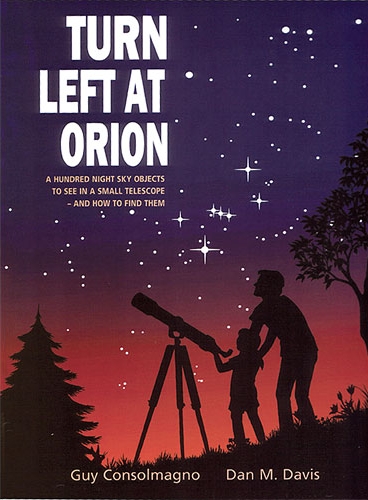
Available from Orion but occasionally
for less money at Amazon
.
A superb book if your first telescope a little larger (like the 6" scope at the top of the page):
NightWatch, 4th Edition, by Terence
Dickinson
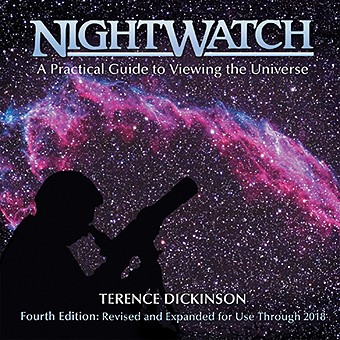
This is an excellent book; it covers all kinds of topics including how to use your scope, what to look for (based on the seasons). Highly recommended.
Available from Orion but sometimes less
expensive from Amazon
.
This book is around $30 at bookstores like Borders.
If you live where there is a lot of light pollution the Moon may be your most visible astronomical target. This excellent book will help you locate and identify all kinds of fascinating features on the Moon:
Discover the Moon Book
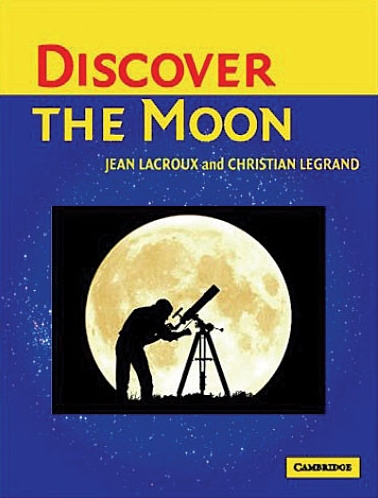
This book is around $15 plus shipping. The book covers what you can see on the Moon on a night by night basis and also talks about basic lunar photography should you want to try that. Below are a few images from the book (I can't show anything too detailed as it is a copyrighted work):
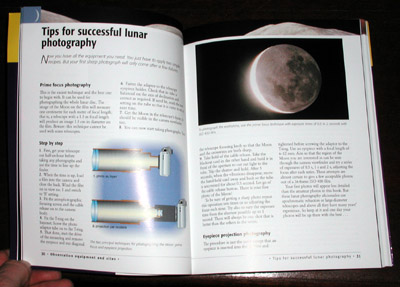
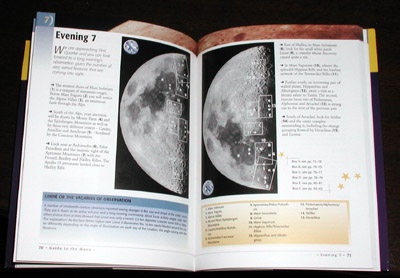
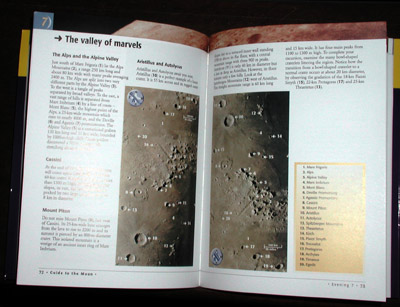
"Back"
links, e-mail and Copyright
Use your browser's "back" button, or use links below if you arrived here via some other path:
This page is part of the site Amateur Astronomer's
Notebook.
E-mail to Joe Roberts
Images © Copyright Orion Telescope and Binocular; HTML text © Copyright 2008,
2009 by Joe Roberts.
